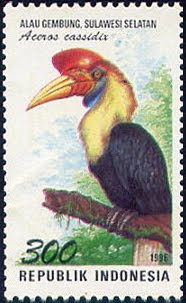The postal authority of Republic of China (Taiwan) issued beautiful dragonfly stamps and souvenir sheets in three series. Series I was issued on October 11, 2000 depicting dragonflies found at forest stream; series II was issued on July 25, 2003 depicting dragonflies found at pond; and series III was issued on August 16, 2006 depicting dragonflies found at paddy field. Different aquatic habitats have different dragonfly species. Altogether 12 species of dragonflies are shown on the stamps and souvenir sheets. Taiwan has more than 120 dragonfly species. These dragonfly stamps are unique because different behaviours of the dragonflies are displayed on the stamps - perching (resting), hovering (hanging on the air), egg laying, courting (the female is guarded by male particularly during egg laying) and mating.
Dragonflies of forest stream
October 11, 2000 Anatogaster sieboldii, Trithemis festiva
Anatogaster sieboldii, Trithemis festiva
Lamelligomphus formosanus; Neurothemis ramburiiThe behaviours shown on the stamps are egg laying and perching.
Anatogaster sieboldii is laying egg by inserting its tail into water. On the other hand,
Trithemis festiva,
Lamelligomphus formosanus and
Neurothemis ramburii are just doing normal perching.
 Dragonflies of pond
Dragonflies of pond
July 25, 2003 Sympetrum eroticum, Rhyothemis variegata
Sympetrum eroticum, Rhyothemis variegata
Acisoma panorpoides, Anax parthenopeThe behaviour shown on the stamps are mating, hovering, egg laying and perching. A pair of
Sympetrum eroticum is shown in the first stamp. This pair of
Sympetrum eroticum is in the middle of mating. The male is red and the female is yellowish brown.
Rhyothemis variegata likes to hover on the air, they just look like very small kite flying high in the air.
Acisoma panorpoides is perching on a leaf.
Anax parthenope is laying eggs by inserting its tail into plant tissue beneath the water.
 Dragonflies of paddy field
Dragonflies of paddy field
August 16, 2006 Orthetrum pruinosum, Dipacodes trivalis
Orthetrum pruinosum, Dipacodes trivalis
Crocothemis servilia, Orthetrum sabinaA pair of
Orthetrum pruinosum is depicted in the first stamp. The male is red and the female is yellowish brown. The female is laying eggs by touching its tail on the surface of water, and the eggs will drop into the bottom of water. At the same time, the male (red) is guarding/courting the female so that other males could not approach and grab the female. On the other hand,
Dipacodes trivalis,
Crocothemis servilia and
Orthetrum sabina are perching on stick, log and plant. The style of perching (the style is called obeliks) for
Dipacodes trivalis is particularly interesting. This obeliks style having the abdomen pointing up to air is to avoid over heating by sun onto its abdomen during hot sunny day.

Of the 12 dragonfly species in the stamps, seven species can be found in the Peninsular Malaysia, i.e.
Acisoma panorpoides,
Trithemis festiva Neurothemis ramburii,
Orthetrum pruinosum,
Dipacodes trivalis, Crocothemis servilia and
Orthetrum sabina. Actually, Peninsular Malaysia has more dragonfly species than Taiwan. More than 240 dragonfly species have been recorded in Peninsular Malaysia.
Click here to learn more about the dragonflies and damselflies of Malaysia.


































